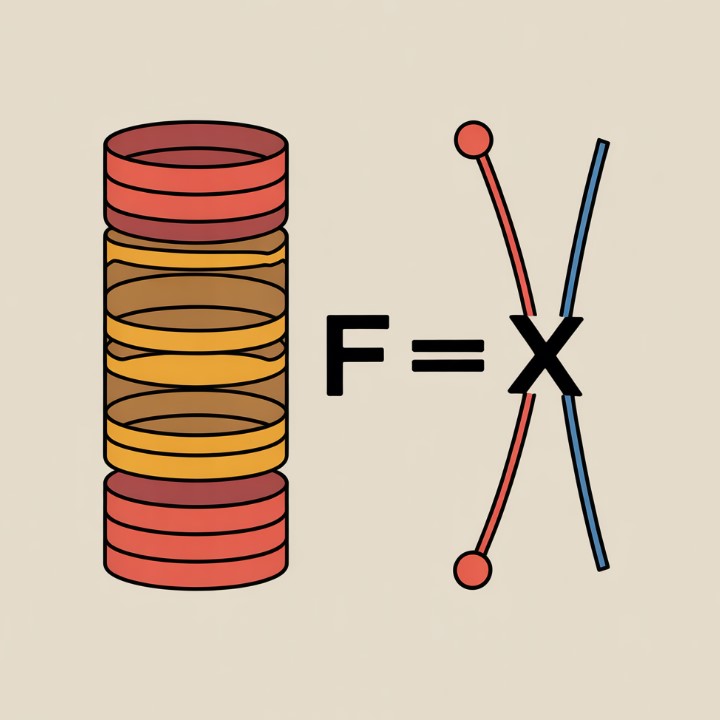Contents
A basketball’s bounce demonstrates the Law of Conservation of Energy, where its predictable potential energy transforms into kinetic motion before scattering into the extremely unpredictable forms of heat, sound, and the physical deformation of a ball that momentarily forgets its own shape.
The Universal Observation
You’ve seen the scene a thousand times, a small ritual played out on the altar of pavement. A basketball is released from shoulder height, a silent promise betrayed by the pull of the earth. The orange sphere accelerates downwards, surrendering its height to gravity’s relentless appetite. It strikes the ground with a sharp thwack, the audible receipt for a transaction of force, and leaps back towards its origin. But it always falls short, a small but undeniable monument to inefficiency.
Why does this happen, this failure to return? The question is simple, but its answer is a thread that unravels the fabric of the universe. If gravity is a constant, the bounce should be an equal and opposite reaction, a perfect mirror of the fall. The “lost” energy, however, hasn’t vanished into some cosmic void; it has merely been mugged in a dark alley of physics. The ball’s journey is a demonstration of the Law of Conservation of Energy, a rule which states that energy is never destroyed, only forced into a new and often less glamorous line of work. The energy isn’t gone; it has simply become heat, sound, and a memory of being squashed.
The Energy Players: Potential and Kinetic
To understand this energy heist, we must first identify the forms it takes, beginning with the two most prominent players who are locked in a perpetual dance of exchange.
Potential Energy (The “Before”)
At its peak, held motionless in your hand, the ball is saturated with Gravitational Potential Energy (GPE), a caged ghost of the motion it will soon become. This is the energy of “what if,” stored not in the ball itself but in its relationship with the massive planet beneath it. Lifting the ball against gravity is like winding a watch, tightening a spring of possibility that physics is eager to release. You have filled its bank account with height, an investment that is about to mature with catastrophic speed.
Kinetic Energy (The “During”)
The moment your fingers part, the conversion is immediate and total, a waterfall of purpose. As it descends, that stored potential unspools violently into Kinetic Energy (KE), the raw currency of movement itself. The stillness is traded for velocity, with every inch of lost height adding another decimal point to its speed. Just before impact, the ball is at its richest in kinetic energy and its poorest in potential, a blur of orange screaming towards its inevitable confrontation.
The Universe’s Perfect Accounting
This entire exchange is overseen by the universe’s strictest rule: energy is only transformed, never truly destroyed. This Law of Conservation of Energy is less a law and more an unbreakable cosmic accounting principle, ensuring every joule is accounted for across the entire system. In a perfect, hypothetical world—a frictionless vacuum where objects are perfectly rigid—our basketball would bounce forever, a pendulum swinging between potential and kinetic states for all eternity. Our world, however, is a gloriously messy place, full of friction and noise and consequences.
The Moment of Impact: An “Inelastic” Collision
The bounce is a collision, an event of such brief and violent transformation that it redefines the ball’s reality. Physicists categorize such events, separating the clean from the messy, the ideal from the real.
An “elastic” collision is a theoretical dream, a perfect exchange of momentum between two objects, like ghosts passing through one another without losing a single wisp of energy. The basketball’s bounce, however, is an “inelastic” collision, a term which simply means the collision has costs. This doesn’t mean the ball hits the ground like a bag of wet cement; it means the bounce is taxed. While it is a mostly elastic event, that small percentage of inelasticity is where our mystery is solved, where the energy leaks into the wider world.
The Squish Factor
For one chaotic millisecond, the basketball is no longer a basketball. In that instant of impact, the ball experiences a moment of profound indecision, briefly forgetting it was ever a sphere at all. It flattens against the ground in an act of deformation, its structure absorbing the kinetic shockwave like a shield. This act of compression, this violent, rubbery groan, requires a tremendous amount of energy, and the spring-back is never quite as energetic as the initial squish.
Where the “Lost” Energy Goes: The Three Main Culprits
The energy that doesn’t push the ball back up into the sky is the “tax” from the inelastic collision, and it’s paid out to several invisible creditors who were waiting patiently for their share.
1. Heat (Thermal Energy): The Silent Thief
Thermal energy is the first thief, a ghost slipping out through the back door of molecular friction. As the ball’s rubbery shell deforms and snaps back, its internal molecules rub against one another, generating a tiny, useless puff of heat. If you were to bend a paperclip back and forth until it breaks, the bent point would feel hot, a tangible testament to kinetic energy being converted into thermal waste. The same microscopic war is waged within the basketball and the surface it strikes, turning a fraction of the bounce into a temperature change so small it feels like a secret.
2. Sound (Acoustic Energy): The Audible Proof
That resonant thwack is pure acoustic energy, the sound of a debt being paid to the air. The impact causes the ball and the ground to vibrate, sending pressure waves rippling outwards that your ear interprets as the signature sound of the game. Creating these waves requires energy, meaning the sound itself is a slice of the kinetic pie that will never become bounce height again. The louder the sound, the more expensive the bounce, an audible announcement of the energy that has permanently left the system.
3. Deformation Energy (The Rebound’s Cost)
Here lies the deepest paradox of the bounce. The ball’s springiness, its very ability to rebound, is also a source of its energy loss. The act of deformation itself is an energy tax, the price the ball pays for the privilege of remembering its shape. Not all of the energy that goes into the compression is returned during the expansion; some is lost as internal heat within the rubber’s structure. The floor, too, gives a little, absorbing a portion of the impact and turning it into its own internal vibrations and heat, a silent accomplice in the theft.
The Co-Conspirators: Other Factors That Steal the Bounce
Beyond these three primary culprits, a gang of other factors conspires to ground the basketball, each stealing its own small share of the energy.
- Air Resistance: The air is not empty space; it is a thick soup of molecules that wages a constant, low-grade war against motion. As the ball falls and rises, it experiences drag, a constant sandpaper whisper against its skin that bleeds kinetic energy away as heat.
- The Bouncing Surface: The floor is not a passive observer but an active participant in the energy exchange. A hard concrete surface is a miser, absorbing very little energy and allowing for a good bounce. A plush carpet, by contrast, is a graveyard for kinetic energy, its fibers bending and creating friction that deadens the impact almost completely.
- The Ball Itself: The state of the ball is its own character reference in the story of the bounce. A properly inflated ball is an optimist, its pressurized air providing a firm and efficient spring. A flat basketball is a leather bag of excuses, absorbing the impact with a pathetic sigh and returning almost none of it. A cold ball is just as bad, its stiff molecules refusing to spring back with any enthusiasm.
Conclusion: The Beautiful, Inefficient Truth
We return, finally, to the falling basketball, but we see it now not as a simple toy but as a vessel for frantic, complex energy transactions. The clean, predictable fall from potential to kinetic energy ends in a messy, unpredictable explosion of transformation upon impact. The bounce is not a single event but a negotiation.
The ball strikes the floor, and its singular kinetic purpose is shattered into a thousand smaller destinies. Most of its energy becomes heat, a silent scream of friction. A small, loud part becomes the sound that defines the game. Another portion is consumed by the very act of deformation, the cost of being resilient. In the end, no energy was lost to the universe’s ledger, but it was irrevocably lost to the basketball’s ambition of returning to your hand.
So the next time you see a basketball dribbled, you’re not just watching a game; you are witnessing a frantic, beautiful conversation between order and chaos. That steady, rhythmic sound is not the sound of perfection, but the sound of constant, unavoidable, and beautifully inefficient loss.







